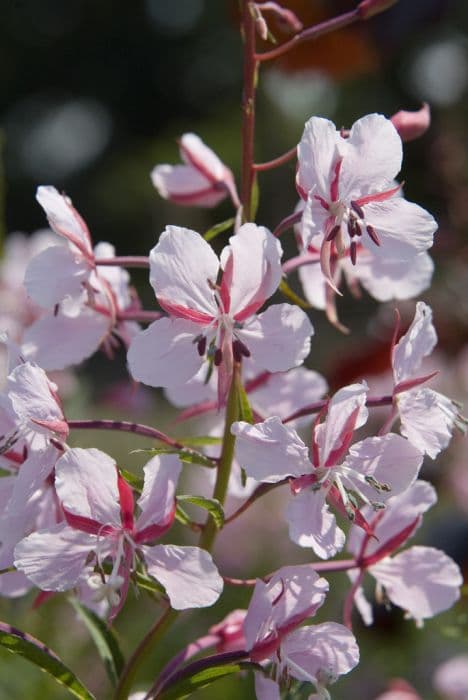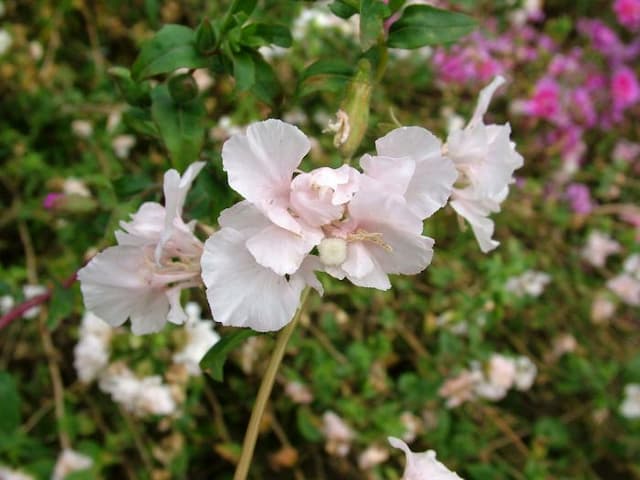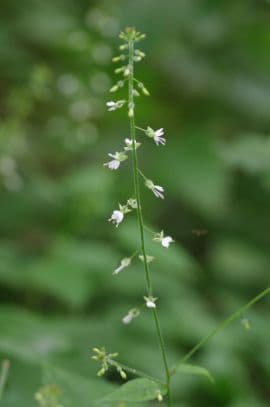Fuchsia Fuchsia 'Alice Hoffman' (d)

ABOUT
The Fuchsia 'Alice Hoffman', a delightful plant known for its ornamental qualities, boasts a display of beautifully contrasting flowers and foliage. This particular variety shows off charming blooms that feature a blend of pink and white hues. The flowers are uniquely shaped, resembling dainty, hanging lanterns or droplets, and they typically have a teardrop form which is characteristic of the fuchsia genus. The petals are often a soft pink color, while the sepals—the leaf-like parts that encase the bud—tend to be a paler, almost white shade. The foliage of the 'Alice Hoffman' fuchsia is similarly attractive, providing a lush backdrop for the standout flowers. Leaves are typically a bright, fresh green and may exhibit a slight glossy sheen. These leaves are typically arranged oppositely along the stem and have a smooth margin. Occasionally, the foliage might show a hint of bronze or dark green, which contrasts well with the delicate coloring of the flowers. The overall impression that Fuchsia 'Alice Hoffman' imparts is one of gracefulness and vibrant, albeit gentle, coloration. Its cascading flowers and buoyant leaves make this plant a favorite among gardeners who seek to add a touch of elegance to their garden spaces.
About this plant
 Names
NamesSynonyms
Alice Hoffman Fuchsia, Lady's Eardrops
Common names
Fuchsia 'Alice Hoffman'
 Toxicity
ToxicityTo humans
Fuchsia is generally considered to be non-toxic to humans. Most fuchsias, including 'Alice Hoffman', can be safely handled and are not known to cause poisoning when touched or ingested. Consequently, there are no symptom specifics to describe as ingestion typically does not lead to serious health issues. However, as with any plant, individual allergies or sensitivities could produce mild reactions in some people.
To pets
Similar to humans, Fuchsia is not considered to be toxic to pets. It is generally safe for cats, dogs, and other household animals if they happen to ingest parts of the 'Alice Hoffman' fuchsia. There are no significant symptoms of poisoning associated with the ingestion of this plant, which means that it is unlikely to cause any serious health consequences for pets. Nevertheless, it is always a good practice to prevent pets from eating plants, as individual animals may have different reactions or sensitivities.
 Characteristics
CharacteristicsLife cycle
Perennials
Foliage type
Deciduous
Color of leaves
Green
Flower color
Pink
Height
1-2 feet (0.3-0.6 meters)
Spread
1-2 feet (0.3-0.6 meters)
Plant type
Shrub
Hardiness zones
9
Native area
Central and South America
Benefits
 General Benefits
General Benefits- Attractive Flowers: Fuchsia 'Alice Hoffman' is known for its beautiful pendulous flowers, which add a splash of color to gardens and outdoor spaces.
- Long Blooming Season: This plant typically has a lengthy flowering period, providing visual interest throughout the summer and into fall.
- Hummingbird Attractant: The vibrant flowers are particularly attractive to hummingbirds, helping to bring wildlife into the garden.
- Shade Tolerance: Fuchsia 'Alice Hoffman' can thrive in partially shaded areas, making it suitable for planting under trees or in areas that don't receive full sun.
- Container Gardening: Due to its compact size and cascading habit, it's well-suited for hanging baskets and containers, offering flexibility in garden design and space utilization.
- Ease of Care: Fuchsias are generally easy to care for, requiring regular watering and occasional feeding to thrive.
 Medical Properties
Medical PropertiesThis plant is not used for medical purposes.
 Air-purifying Qualities
Air-purifying QualitiesThis plant is not specifically known for air purifying qualities.
 Other Uses
Other Uses- Ink Dye: The vibrant blossoms of Fuchsia can be crushed to produce a natural dye for fabrics or inks, creating a unique and eco-friendly alternative to synthetic dyes.
- Edible Arrangements: The flowers of Fuchsia are edible and can be used to add a pop of color and subtle flavor to salads or as a garnish on desserts and drinks.
- Eco-friendly Confetti: Dried Fuchsia petals can be used as biodegradable confetti for celebrations, reducing the environmental impact compared to traditional plastic confetti.
- Photography Subject: With their striking appearance, Fuchsia flowers are excellent subjects for macro photography, providing a natural spectacle of form and color.
- Craft Supplies: The flowers and seed pods can be used in dried floral arrangements, wreaths, or for other craft projects, giving them a second life after they bloom.
- Natural Potpourri: Fuchsia flowers can be dried and mixed with herbs to create fragrant potpourri, offering a natural way to freshen up living spaces.
- Floating Decorations: The buoyant flowers can be floated in water bowls or fountains for decorative purposes during events or as part of a tranquil garden setting.
- Bookmarks: Pressed Fuchsia flowers can be laminated to create unique and decorative bookmarks, preserving their beauty in a practical form.
- Tea Flavoring: Some Fuchsia flowers can be used to infuse teas, adding a floral note to the beverage (note: ensure the variety is safe for consumption).
- Baking Decoration: Candied Fuchsia flowers can serve as an elegant and edible decoration on cakes and pastries, enhancing the visual appeal of baked goods.
Interesting Facts
 Feng Shui
Feng ShuiThe Fuchsia is not used in Feng Shui practice.
 Zodiac Sign Compitability
Zodiac Sign CompitabilityThe Fuchsia is not used in astrology practice.
 Plant Symbolism
Plant Symbolism- Confiding Love: Fuchsia's delicate, hanging flowers are often associated with confiding love, representing a deep and intimate bond between individuals.
- Elegance and Grace: The elegant design and graceful droop of the fuchsia flower symbolizes a classy and delicate composure.
- Good Taste: Given its beautiful appearance, a fuchsia is also symbolic of good taste and sophistication in personal preferences and style.
- Ambiguity and Contradiction: The unique shape and vibrant colors of the fuchsia flower can represent complexity and contradiction, reflecting life's unpredictable nature.
 Water
WaterFuchsia, commonly known as Lady's Eardrops, prefers consistently moist soil without being waterlogged. It's important to water the plant when the top inch of soil feels dry, which typically means watering once or twice a week. However, during hotter, drier periods, you may need to water every other day. A thorough watering should be administered so that water runs through the drainage holes, indicating the entire root ball is moistened. On average, this could mean using approximately half a gallon of water for a medium-sized pot every week, but adjust the amount according to temperature and humidity conditions.
 Light
LightLady's Eardrops thrive in bright, indirect sunlight. The ideal spot for these plants is where they can receive morning sunlight and afternoon shade, as direct afternoon sun can be too intense and may cause leaf scorch. They do well in a north- or east-facing window or a shaded southern or western exposure.
 Temperature
TemperatureLady's Eardrops prefer a cool to moderate temperature, thriving best between 55 to 75 degrees Fahrenheit. They can survive temperatures as low as 40 degrees but should be protected or brought indoors if the temperature is expected to drop further. Ideal growing conditions are in the cooler end of their temperature range.
 Pruning
PruningPruning Lady's Eardrops is essential for promoting bushier growth and abundant flowering. Prune back the tips of the branches in late winter or early spring before new growth begins to encourage branching. Throughout the growing season, remove faded flowers and seed pods to encourage continued blooming. The best time for heavier pruning is when the plant is dormant, usually after the last frost.
 Cleaning
CleaningAs needed
 Soil
SoilLady's Eardrops prefer a soil mix that is rich, moist, and well-draining with a pH between 6 and 7. A mixture of peat, loam, and sand or perlite can encourage healthy growth. Regularly check the soil moisture to ensure it remains consistently damp without being waterlogged.
 Repotting
RepottingLady's Eardrops should be repotted annually in spring or every two years if growth is slower. Choose a slightly larger pot to allow for root growth. Ensure the new pot has adequate drainage and use fresh potting mix to replenish nutrients.
 Humidity & Misting
Humidity & MistingLady's Eardrops thrive in high humidity, ideally between 60% and 70%. To maintain these levels, you may use a humidifier, place a humidity tray beneath the plant, or mist the foliage regularly.
 Suitable locations
Suitable locationsIndoor
Place Lady's Eardrops in bright, indirect light with high humidity.
Outdoor
Plant Lady's Eardrops in partial shade; shelter from strong winds.
Hardiness zone
10-11 USDA
 Life cycle
Life cycleFuchsia 'Alice Hoffman', commonly known as Alice Hoffman Fuchsia, begins its life cycle with seed germination, which occurs in warm, moist soil conditions typically in the spring. The seedlings emerge and grow into young plants with distinctive fuchsia foliage. As the plants mature, they develop a bushy structure and start to produce buds which bloom into the characteristic pendulous fuchsia flowers, usually pink and white, throughout the summer months. After pollination, often by hummingbirds or insects, the flowers develop into small fruit containing seeds, completing the reproductive cycle. In the autumn, the plant begins to enter dormancy, with leaves and flowers dropping as temperatures decrease. With proper winter care or in suitable climates, the fuchsia will overwinter and resume growth the following spring, repeating the cycle.
 Propogation
PropogationPropogation time
Spring-Early Summer
The Fuchsia 'Alice Hoffman', commonly known as "Lady's Eardrops" due to its elegant, pendulous flowers, is often propagated through softwood cuttings. This popular method is best carried out in late spring to early summer when the plant is actively growing. To propagate by cuttings, one would select a healthy, non-flowering shoot and cut a 3 to 4-inch (7.6 to 10.16 cm) section just below a leaf joint or node. It's important to remove the lower leaves and dip the cut end into a rooting hormone to encourage root development. The cutting should then be placed in a pot filled with a well-draining potting mix, ensuring at least one node is buried where roots can form. The pot should be kept in a warm, humid environment, out of direct sunlight, and the soil should be kept consistently moist without becoming waterlogged. With proper care, roots will typically form within a few weeks.









